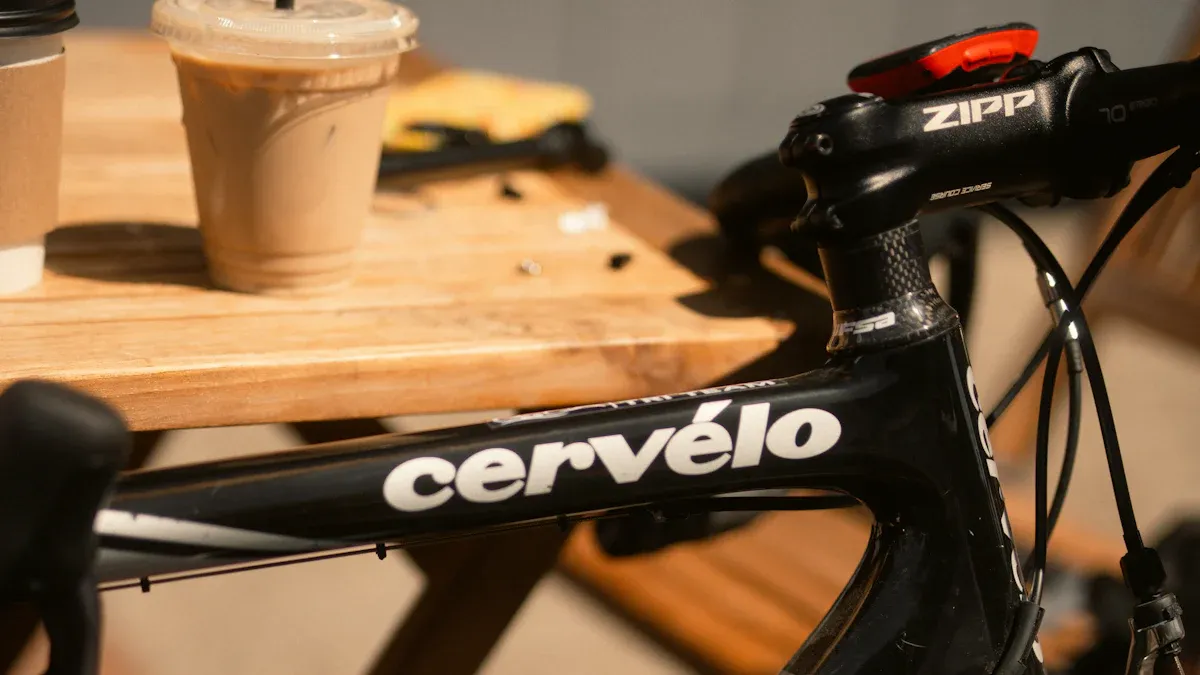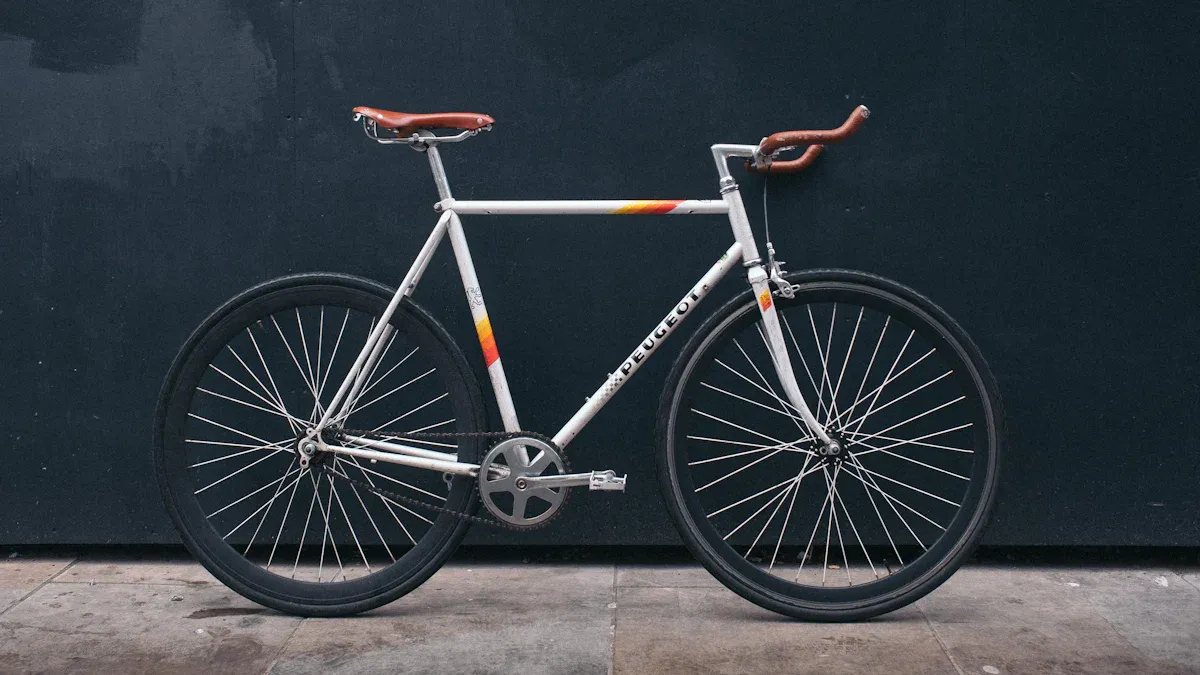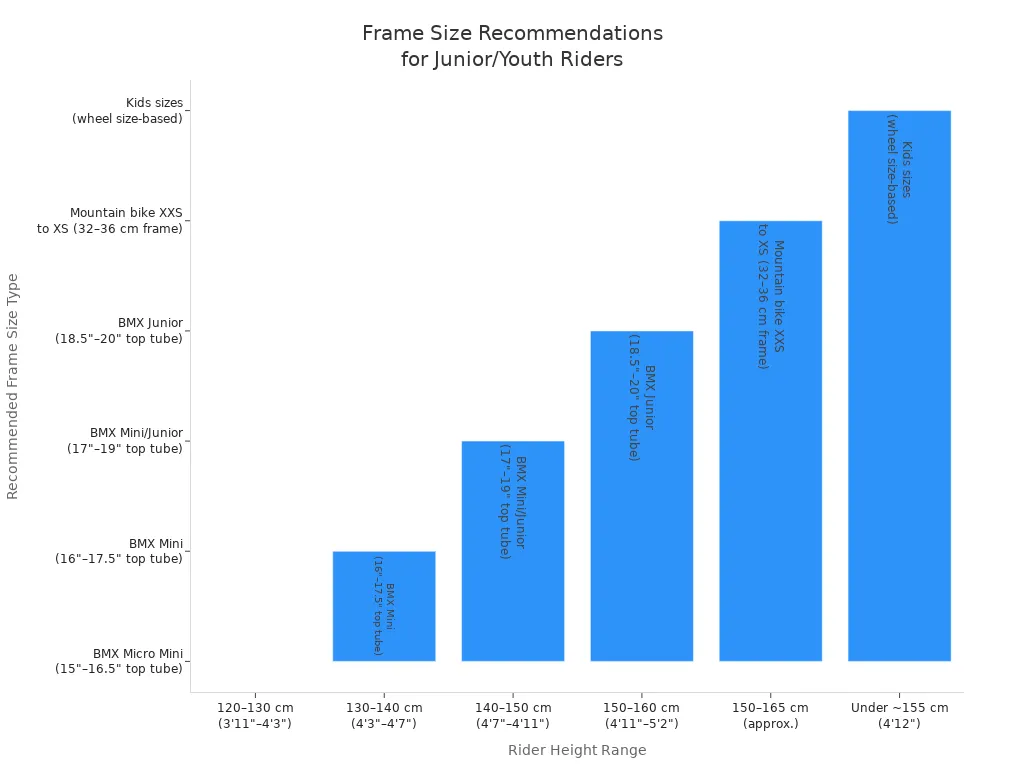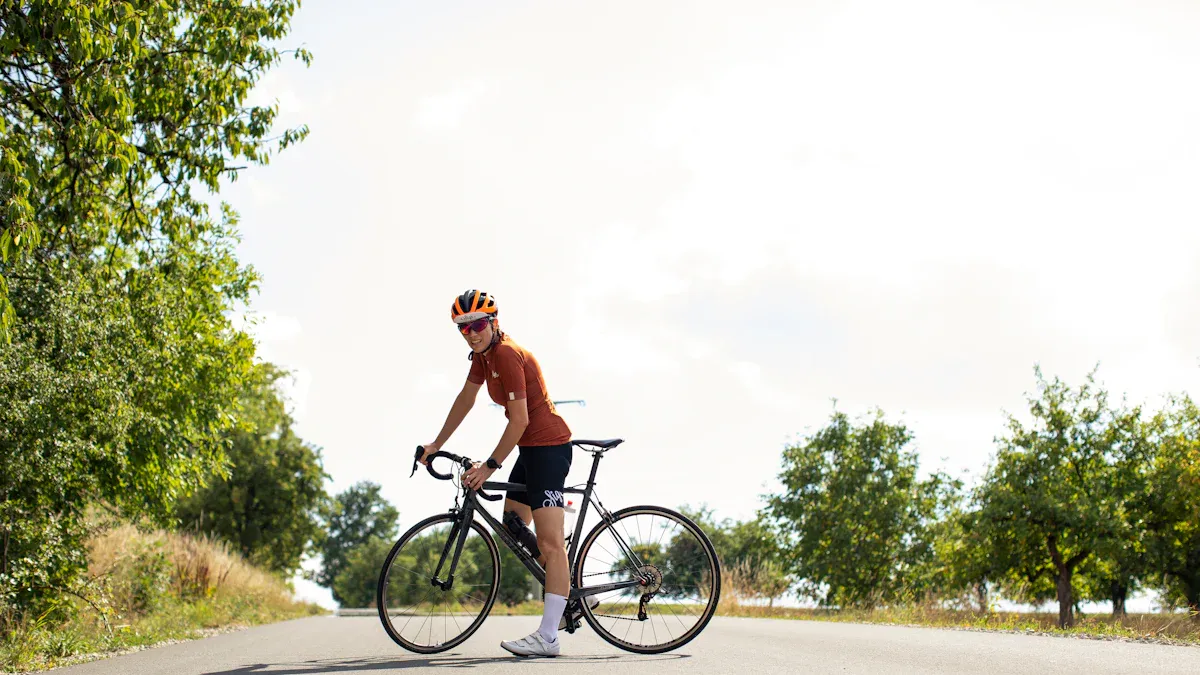
You want to pick the right bike frame size, but where do you start? Your height gives you a general idea, but using both your height and inseam makes a huge difference. Inseam measures your leg length, which helps you find a frame that fits your body instead of just your overall height. This approach lowers the risk of ending up with a bike that feels too big or too small. When you use a racing bike frame size chart and check both measurements, you get a much better fit. Picking the right bike frame size means more comfort and better performance.
Key Takeaways
Measure your height and inseam very carefully to pick the right bike frame size. Inseam is more important than height for a good fit.
Use a racing bike frame size chart to help you, but change things based on your body shape and how you like to ride. This helps you feel comfortable and in control.
Look at important fit parts like standover height, stack, and reach. These help make sure your bike feels balanced and easy to use.
Make small changes to your saddle and handlebars to feel better when riding. For the best fit, think about getting a professional bike fitting.
If you are between sizes, pick the smaller frame and adjust it to fit you. Comfort and your riding style should help you decide.
Racing Bike Frame Size Chart

Your Height and Inseam
When you want to find the perfect racing bike frame size chart, you need to know two things: your height and your inseam. Your height gives you a starting point, but your inseam tells you how long your legs are. This matters because two people with the same height can have different leg lengths. If you only use your height, you might end up with a bike that feels awkward or uncomfortable.
Most professional bike fitters use both measurements. They often use a simple formula: inseam (in centimeters) times 0.7 equals your recommended frame size in centimeters. This formula works well for road bikes and helps you get close to the right fit. For example, if your inseam is 80 cm, you multiply 80 by 0.7 to get a frame size of 56 cm.
Tip: Stand with your back against a wall, place a book between your legs (like a bike seat), and measure from the floor to the top of the book. That’s your inseam!
You should also know that inseam-to-height ratios can vary. Most cyclists have an inseam that is about 42% to 55% of their height. Taller riders usually have longer legs, but not always. That’s why checking both numbers is so important.
Using the Chart
Now, let’s look at a racing bike frame size chart. This chart matches your height and inseam to the recommended frame size. You’ll see sizes in centimeters and standard labels like XS, S, M, L, and XL. These sizes help you find a bike that fits your body, not just your height.
Rider Height (cm) | Rider Height (ft/in) | Inseam (cm) | Frame Size (cm) | Frame Size Label |
|---|---|---|---|---|
147–152 | 4’10″–5’0″ | 66–70 | 47–48 | XXS |
152–160 | 5’0″–5’3″ | 70–74 | 48–50 | XS |
160–168 | 5’3″–5’6″ | 74–78 | 51–53 | S |
168–175 | 5’6″–5’9″ | 78–82 | 54–55 | M |
175–183 | 5’9″–6’0″ | 82–86 | 56–58 | L |
183–191 | 6’0″–6’3″ | 86–90 | 58–60 | XL |
191–198 | 6’3″–6’6″ | 90–94 | 61–62 | XXL |
You can use this bike size chart as a starting point. If your inseam is longer than average for your height, you might want a slightly bigger frame. If your legs are shorter, a smaller frame could feel better. Some riders have a long torso and short legs, or the other way around. In these cases, you may need to try different sizes or adjust the seat and handlebars.
Note: The racing bike frame size chart is a guide, not a rule. Your comfort and riding style matter most. If you fall between two sizes, think about how you like to ride. Smaller frames feel more agile and fast, while larger frames offer more comfort.
For junior or youth riders, frame sizes change. Kids’ bikes use wheel size instead of frame size. BMX bikes use top tube length. Here’s a quick chart for younger riders:
Rider Height Range | Recommended Frame Size Type | Notes |
|---|---|---|
Under ~155 cm (4’12”) | Kids sizes (wheel size-based) | Smaller frames, better fit for youth riders |
120–130 cm (3’11″–4’3″) | BMX Micro Mini (15″–16.5″ top tube) | Youth BMX size for smallest riders |
130–140 cm (4’3″–4’7″) | BMX Mini (16″–17.5″ top tube) | Junior BMX size |
140–150 cm (4’7″–4’11”) | BMX Mini/Junior (17″–19″ top tube) | Transition size for juniors |
150–160 cm (4’11″–5’2″) | BMX Junior (18.5″–20″ top tube) | Junior BMX standard size |
150–165 cm (approx.) | Mountain bike XXS to XS (32–36 cm frame) | Smaller mountain bike frames for youth |

Remember, the best bike frame size depends on your height, inseam, and how your body is built. Some people have longer legs or arms, which can change what feels right. Modern bikes no longer use different size charts for men and women. Instead, they focus on fitting each rider’s unique shape and style.
If you feel unsure, try out a few bikes or ask for help at your local shop. Adjustments to the seat or handlebars can make a big difference. The racing bike frame size chart gives you a strong starting point, but your comfort and performance come first.
Measure for the Right Bike Frame Size

Measure Your Height
Getting your height right is the first step to finding the right bike frame size. Stand up straight with your back against a wall. Take off your shoes and stand on a hard floor. Use a flat object, like a book, and place it on top of your head. Make sure the book is level. Mark the spot where the bottom of the book touches the wall. Use a tape measure to check the distance from the floor to the mark. Write down your height in centimeters and inches. This number will help you match up with the bike frame size chart.
Tip: Always measure your height barefoot for the most accurate result. Shoes can add extra height and throw off your frame size measurement.
Measure Your Inseam
Your inseam is even more important than your height when you want to measure bike size. To measure your inseam, stand with your back against a wall. Take off your shoes and stand on a hard surface. Place a hardcover book between your legs, pressing it up as if you were sitting on a bike saddle. The top of the book should be flat and level. Mark the spot on the wall at the top of the book. Measure from the floor to this mark. This is your inseam length.
Use a tape measure for accuracy.
Repeat the process two or three times and take the average.
Do not use your pants inseam or inside leg measurements from clothing. These are often too short and can lead to the wrong bike frame size.
Many bike fitters use your inseam to calculate the correct frame size. For example, the Lemond Sizing Chart and Hamley Method use your inseam to find the best saddle height and frame size for you. These methods have been tested and help you ride more comfortably and efficiently.
Compare to Frame Size
Now that you have your height and inseam, you can use them with a bike frame size chart. Look for your height and inseam in the chart. Find the frame size that matches both numbers. If your inseam is longer than average for your height, you might need a bigger frame. If your legs are shorter, a smaller frame could fit better.
Some riders have longer arms or torsos. If you have long arms, you may feel more comfortable on a larger frame. If you have long legs and a short torso, you might prefer a smaller frame with a taller head tube. Adjustments like changing the stem length or seat position can help you fine-tune your fit.
🚴♂️ No two riders are the same. Your body shape can change what feels right. Always use both your height and inseam to find the right bike frame size. If you fall between sizes, think about your riding style and comfort.
Many people make mistakes by only looking at wheel size or ignoring their inseam. The best way to measure bike size is to use both your height and inseam together. This helps you avoid a bike that feels too big or too small. Remember, the correct frame size will help you ride faster, safer, and with more comfort.
Finding the Right Bike Frame Size
Standover Height
When you stand over your bike, you want to check the bike standover height. This is the space between the top tube and the ground. Most riders look for about an inch of clearance between the top tube and their body. This small gap helps you get on and off the bike easily. Some riders feel okay if their body touches the top tube, but a little space can make you feel more confident, especially if you need to stop quickly.
Some people think standover is all about safety, but it is really about getting the right fit.
In a crash, the bike is rarely straight up, so a small standover gap does not always prevent injury.
Many riders care more about leg extension and reach than standover alone.
Your experience and comfort matter most when you check standover.
Tip: If you feel good standing over your bike and can touch the ground with your feet, you are on the right track for a good fit.
Stack and Reach
Stack and reach are two numbers that help you find the right bike frame size. Stack is the height from the bottom bracket to the top of the head tube. Reach is the length from the bottom bracket to the center of the head tube. These numbers tell you how your body will fit on the bike.
Stack affects how high your handlebars sit. A higher stack gives you a more upright and relaxed position.
Reach tells you how far you stretch to grab the handlebars. A longer reach means a more stretched-out, racing position.
The right stack and reach help you get a fit that feels balanced and lets you ride longer without pain.
If you pick a frame with the right stack and reach, you will not need to use too many spacers or make big changes to your handlebars.
Comfort and Performance
Getting the right fit is not just about numbers. It changes how you ride and how you feel on your bike. If your frame is too big, you might feel stretched out and get sore in your back, neck, or arms. If your frame is too small, the bike can feel twitchy and hard to control. Over time, a bad fit can cause pain and even injuries.
Professional cyclists sometimes choose smaller frames. They do this to get lower on the bike and cut through the wind. A smaller frame can help them go faster, but it takes strong core muscles and lots of practice to ride in that position.
When you focus on finding the right bike frame size, you get a fit that matches your body and your style. You will ride with more comfort, better control, and more power. Always remember, the best fit is the one that feels right for you.
Brand and Sizing Differences
Manufacturer Charts
You might think all bikes use the same sizing, but every brand does things a little differently. Some brands measure frames in centimeters, while others use inches. Road bikes usually use centimeters, which matches the more stretched-out, racing position. Mountain bikes often use inches and focus on a more relaxed fit. Hybrid bikes can follow either method, depending on the brand.
When you look at a road bike size guide, you’ll see that brands use different measurements like seat tube length, top tube length, reach, and stack. These numbers change how the bike feels when you ride. For example, a 54 cm frame from one brand might feel different from a 54 cm frame from another. That’s why you should always check the manufacturer’s chart before picking the right bike size.
Road bike frames: 48–62 cm (more aggressive posture)
Mountain bike frames: 13–23 inches (relaxed geometry)
Key measurements: seat tube, top tube, reach, stack
Tip: Always use the brand’s own bike sizing guide. This helps you match your height, inseam, and riding style to the right bike size.
Between Sizes
Sometimes you find yourself between two sizes on the chart. Don’t worry—this happens to a lot of riders! Experts usually suggest picking the smaller frame. A smaller bike is easier to adjust for comfort. You can raise the seat or change the stem to get the fit just right. If you pick a frame that’s too big, you might feel stretched out, lose power, or even risk injury.
Your riding style matters, too. If you like a fast, aggressive ride, a slightly larger frame might give you more reach. If you want comfort and control, a smaller frame can help you stay relaxed. Test rides are a great way to feel the difference. You can also ask for a professional fitting if you want the perfect match.
Choose the smaller size if you’re unsure.
Adjust the seat, handlebars, and stem for comfort.
Think about your riding style—race or endurance.
Use a road bike sizing guide to compare options.
Remember: The right bike size is the one that feels best for your body and your rides.
Adjustments and Fitting
Simple Adjustments
You can make a big difference in how you fit your bike with a few simple tweaks. Even if your frame size is not perfect, these changes help you ride more comfortably and safely. Here are some easy ways to improve your fit:
Raise or lower your saddle to match your leg length. Try the heel-on-pedal method: Sit on your bike, put your heel on the pedal at the lowest point, and check that your leg is just slightly bent.
Move your saddle forward or backward. Use a plumb line from your kneecap to the pedal axle to find the right spot.
Keep your saddle level. If it tilts too much, you might slide forward or backward, which can hurt your hands or back.
Adjust your handlebars. You can raise them or use a shorter stem to bring them closer. This helps if you feel stretched out or have pain in your neck or shoulders.
Pick the right saddle width and shape. Narrow saddles work for racing positions, while wider ones feel better if you sit more upright.
Try handlebars with a shorter reach if you have trouble reaching the brake hoods.
Warm up and stretch before riding. Good flexibility in your hips and legs helps you handle your bike better.
Tip: Simple adjustments can help a smaller frame fit your body, but a frame that is too large is harder to fix. Always start with the best bike fit you can get.
Professional Bike Fitting
Sometimes, you need more than simple changes to fit your bike perfectly. That’s when a professional bike fitting comes in. Experts use special tools and technology to give you personalized fit recommendations. They look at your body shape, flexibility, and riding style to make sure every part of your bike matches you.
A professional fitting can help you:
Ride longer and more comfortably by fixing pain in your back, neck, or knees.
Pedal more efficiently, which means you can go faster with less effort.
Avoid injuries like numbness or soreness by making sure your posture is right.
Get the best setup for your shoes, cleats, saddle, and handlebars.
Use advanced tools like video analysis or 3D motion capture to check your movement and make tiny adjustments.
Many riders notice they can ride farther and faster after a fitting. Some even see their power go up by 15 watts or more. You might also find it easier to hold an aerodynamic position during long rides. If you have unique body proportions, a fitter can use custom parts or even design a special frame just for you.
Note: The best bike fit comes from matching your bike to your body, not the other way around. If you want to fit your bike perfectly, consider a professional fitting, especially if you ride often or race.
You can find the right racing bike frame size by measuring your height and inseam, then checking a size chart. Experts say you should focus on seat height and handlebar position for a perfect fit. When you choose a bike that fits, you ride with better comfort and control. A good fit helps you avoid pain and keeps you safe. Try simple adjustments or get a professional fitting if you want the best results. Many riders feel stronger and enjoy riding more after finding their ideal fit. You can achieve a great fit and enjoy every ride.
FAQ
What if I fall between two bike frame sizes?
If you fall between sizes, try the smaller frame first. You can adjust the seat and handlebars for comfort. A smaller frame usually feels easier to control. Test both sizes if you can.
Can I use my pants inseam to measure for a bike?
No, you should not use your pants inseam. Clothing sizes often differ from your real inseam. Always measure your inseam from the floor to your crotch using a book for the most accurate result.
How do I know if my bike frame is too big or too small?
You might feel stretched out or have trouble reaching the handlebars if your frame is too big. If it feels cramped or hard to control, the frame may be too small. Comfort is the best guide.
Do women need a different bike frame size chart?
Most modern bikes use unisex sizing. You should use your height and inseam to find the right fit. Some brands offer women-specific models, but the main thing is to match the bike to your body.
See Also
Using A Bike Frame Size Chart To Get Perfect Fit
Discovering The Perfect Mountain Bike Size Through Geometry
Calculate Your Best Bike Fit Using Frame Size Tools

I have been surfing online more than 3 hours today, yet I never found any interesting article like yours. It’s pretty worth enough for me. Personally, if all website owners and bloggers made good content as you did, the web will be a lot more useful than ever before.